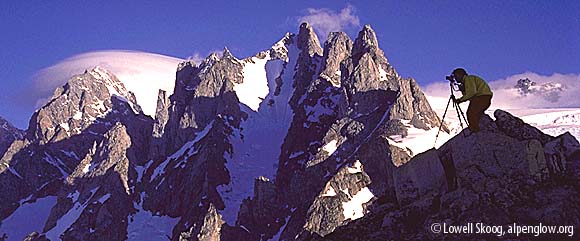
Notes on Photography
I bought my first camera in 1978, a Rollei 35T, to take
pictures on climbing trips. The Rollei is a compact
rangefinder with good optics. Several images on this
website were taken with this camera, and a few have been
published in magazines. When I started to feel limited
by the Rollei’s fixed lens and finicky meter, I
moved on to other cameras—SLR’s with zoom
lenses, sophisticated metering systems, autowinders, and
ultrasonic focusing. These tools helped me improve my eye
for composition and exposure, and produced many of the
images here.
Eventually, I grew dissatisfied with the quality of zoom
lenses and weary of the weight and bulk of SLR systems
in the backcountry. Around this time, Contax released
their G-series rangefinder. The G2 features high quality
interchangeable lenses on a body about half the size of a
typical SLR and perhaps twice the size of my old Rollei.
It’s a compromise system—great for scenics,
not so good for following action—but one that suited
my tastes for several years.
I resisted moving to digital photography for years,
but finally gave in for family trips. I initially
chose a Canon digital SLR, which is compact, good for
shooting action, and compatible with lenses from my older
film cameras. Contrary to my initial expectations, I
haven’t shot a single roll of film since buying the
digital camera. I eventually bought a smaller digital
and have found it so convenient that I stopped using the
SLR entirely. For several years I used cameras for copy
photography to support my historical work, but that ended
when I bought a good multi-purpose scanner.
—Lowell Skoog
Photography
adds to my enjoyment of the outdoors, but it is hardly
ever the main goal of a trip. Usually, I’ll pick
a destination for its own sake and then work photography
around it, rather than letting photography set the agenda.
This attitude makes it unlikely that I’ll ever be a
professional, and it has influenced my choice of tools.